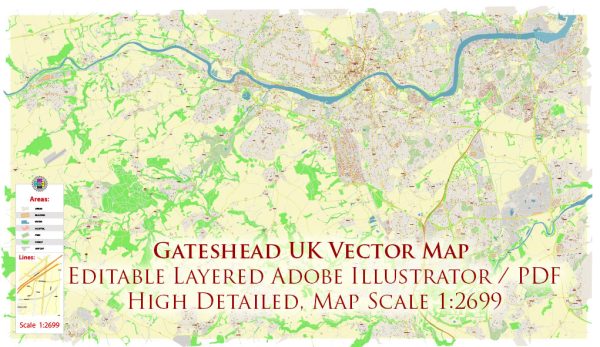Gateshead, located in Tyne and Wear, England, has a rich history of urban development that spans several centuries. Here is a brief overview:
- Medieval and Early Modern Periods (pre-19th century): Gateshead’s history dates back to medieval times when it was a small settlement with agricultural and fishing activities. The town grew around the parish church of St. Mary. The economy was primarily based on agriculture, trade, and river-related activities.
- Industrial Revolution (18th-19th centuries): The industrial revolution had a profound impact on Gateshead. The expansion of coal mining and the development of industries, including iron and steel, transformed the town into a key industrial center. The River Tyne played a crucial role in transporting goods and materials.
- Innovation and Engineering: Gateshead became known for its innovative engineering and manufacturing industries during the 19th century. The famous industrialist Sir Joseph Swan, a pioneer in electric lightbulb development, lived and worked in Gateshead. The town contributed significantly to the industrial advancements of the time.
- Transportation and Bridges: The construction of iconic bridges over the River Tyne greatly influenced urban development. The High Level Bridge, completed in 1849, connected Gateshead to Newcastle and facilitated the movement of goods and people. The innovative design and engineering of these bridges reflected the technological progress of the era.
- Urban Expansion and Architecture (19th-20th centuries): The growth of industry led to population increase, and Gateshead expanded to accommodate the rising number of residents. Victorian and Edwardian architecture characterized this period, with notable buildings like the Gateshead Town Hall, built in the late 19th century, reflecting the architectural styles of the time.
- Post-World War II Reconstruction: Like many industrial cities in the UK, Gateshead experienced damage during World War II. The post-war period saw efforts to rebuild and modernize, with a focus on housing and infrastructure development. New housing estates and commercial areas were established to meet the needs of the growing population.
- Contemporary Development: In more recent decades, Gateshead has undergone further regeneration and redevelopment projects. The construction of the Sage Gateshead, a cultural venue, and the BALTIC Centre for Contemporary Art, along with the Gateshead Millennium Bridge, are examples of efforts to revitalize the town and promote cultural and economic growth.
Overall, Gateshead’s history of urban development reflects its transition from a medieval settlement to a key player in the industrial revolution, followed by post-war reconstruction and contemporary regeneration initiatives, all of which have shaped the town into what it is today.


 Author: Kirill Shrayber, Ph.D.
Author: Kirill Shrayber, Ph.D.